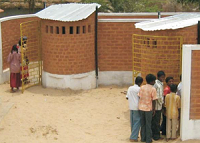
Community based ecological sanitation ( Image courtesy:Practioners Handbook)
Ecological sanitation is based on three fundamental principles: pre-venting pollution rather than attempting to control after we pollute; sanitizing the urine and the faeces; and using the safe products for agricultural purposes. This approach can be characterised as ‘sanitize-and-recycle’. Ecosan toilets and urinals, their operation and maintenance, their use in special conditions like disasters, their implementation, along with a few case studies are explained in the report.
The report is divided into the following chapters:
1. Introduction
This introduces the various issues related to sanitation and its impact on health and the environment. It explains how ecological sanitation is an approach based on the principle of “minimum resource utilization and maximum resource recovery”, offering sound sanitation solutions in a framework of sustainable development.
2. Ecological Sanitation
How ecological sanitation is a more holisitic approach that views human waste as a resource is detailed here. Any sanitation system that sanitises waste and facilitates recovery of useful substances can be termed as an ecological sanitation system. This system renders human excreta safe, preventing pollution, and proposes to use the safe products of sanitized human excreta for agricultural purposes.
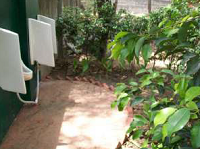
Green Urinal at IIT, Delhi ( Image courtesy: R Sakthivel)
A few cost effective and decentralised ecosanitation systems which can be employed in rural areas to treat human excreta are discussed:
- Ecosan Toilets (UDDT): Urine diverting dehydrating toilets
- Arborloo: A composting toilet widely used in various parts of Africa
- Fossa Alterna: It is like Arborloo but has two pits constructed with ring beams placed over them
- Toilet Linked Biogas Plants: Biogas reactors such as fixed or floating dome utilised to recover useful products from human and animal excreta
- Dewats: Treats sewage, providing useful by-products and the possibility of recycling water used for flushing and washing
- Waterless Urinals: Does not require water for flushing at all and thus saves between 56,800 litres to 1,70,000 litres of water per urinal per year
3. Ecosan Toilets – Design Principles
This chapter deals with the ecosan toilets or urine diverting dry toilets that facilitate separation of urine, faeces and water used for anal cleansing (wash water) at the point of use. Urine and wash water are separated using specially designed toilet seats. These can be constructed in various designs based on factors such as climate, temperature, availability of space, convenience decomposition of faeces and features desired by the users. The design features together with the drawings are detailed in the report.
4. Ecosan Toilets - Planning, Design Considerations and Technological options
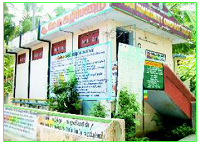
Ecosan community composting toilets ( Image courtesy: R Sakthivel)
The aspects related to planning, design considerations and various technological options for implementing these are discussed. These are further classified into sections such as data collection, site selection, appropriate design, user involvement and implementation.
These design principles and considerations are based on the requirement of users and local climatic conditions. The design considerations are grouped into sections such as anthropometric data, climatic conditions for various zones, suggested design parameters, wind and sunlight penetration for optimal disinfection and drying of toilet units. The technological aspects include standard designs developed for the promotion of ecosan toilets for households, anganwadis, schools and public complexes.
5. Waterless Urinals
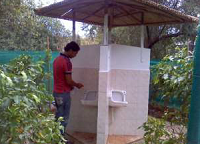
Waterless urinal public kiosk ( Image courtesy: R Sakthivel)
Waterless urinals do not consume water for flushing and are less expensive as they do not require plumbing accessories. Importantly, the dry operation of waterless urinals and touch free operations reduces significantly the spread of communicable diseases. The technical knowhow of constructing these WLU is explained in this section.
6. Hygienic Operation and Maintenance
As these are new concepts, users of these facilities need to be educated on how to use and maintain them properly. Although these are robust technologies compared to other systems, following proper maintenance procedures is very important for their effective functioning.
7. Ecosan in Disaster and Special Situations
This section deals disaster affected areas, where ensuring proper sanitation is very important for preventing disease outbreak. Sanitation systems need to be designed to withstand the impact of disaster situations. Some of the temporary measures in relief operations are:
- Peepoo Bags : It is a single use bio- degradable bag used for defecating and safe disposal of excreta. The chemically treated bag sanitizes human excreta from contaminating the materials
- Ready to Install Ecosan Toilets : These are already available in the market, manufactured using PVC and use little water.
- Mobile Ecosan Toilets : These are put into service during emergencies and other events where emergency sanitation facilities are needed.
8. Safe Application of Human Excreta in Agriculture
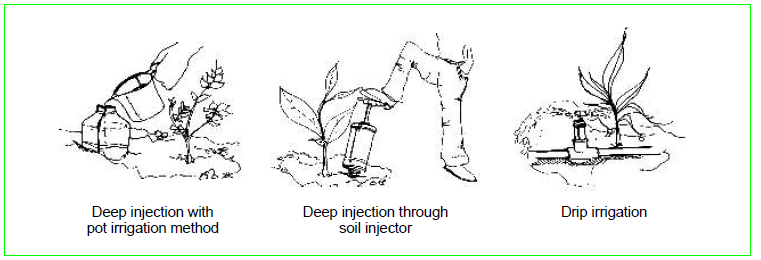
Various methods of urine application to agricultural crops ( Image courtesy: Practioners Handbook)
This chapter deals with source separation of urine and faeces proposed through ecological sanitation concept, and aids in applying different set of treatments to make them safe for reuse in agriculture
Ecosan toilets are designed to process human faeces to a harmless state. The treatment to destroy pathogenic organisms present in human faeces is effected either within or outside the system. Broadly, the process of pathogen inactivation in ecological sanitation systems can be grouped into two categories
- Dehydration ( removal of moisture from faeces through evaporation and addition of dry materials like husk, ash etc.)
- Composting ( oganic substances are mineralized and turned into humus or manure)
9. Implementation Framework
The revised TSC ( Total Sanitation Campaign) framework encourages promotion of ecological sanitation components that allow storage of human excreta and urine, for composting or converting to usable and safe manure or fertiliser. Though no special financial provisions are provided for ECOSAN facilities, however within the existing financial allocations earmarked for toilets, these can be promoted.
10. Case Studies

Pole bean crop grown using human urine and cattle urine ( Image courtesy: GKVK, Bangalore)
National
- Ecosan Community Composting Toilet in Musiri Town Panchayat of Trichy District in Tamil Nadu successfully used since 11th April 2006
- Application of urine as liquid fertilizer to crops on farmers fields by University of Agricultural Sciences, Bangalore
- Decentralized Wastewater Management at “Adarsh Vidya Mandir School” located in Thane district, Maharashtra.
- Improved Traditional Composting Toilets with Urine Diversion in Leh
- Promotion of Ecosan Toilets using Bamboo in Manipur Region
International
- Promotion of Eco-toilets in Gunagxi Province of China
- Use of Compost in Agriculture in Zimbabwe
- Composting Toilets in Sweden
- Promotion of Multiple-vault Composting Toilet “Carousel” in Norway
/articles/practioners-handbook-ecological-sanitation-system-saves-water-prevents-pollution-and-0